Final report for FW20-365
Project Information
With an ever changing climate and new forms of contamination entering our air, water and soil - innovation is crucial to the success of our food system going forward. The purpose of this study is to demonstrate the ability of fungi to remediate environmental toxins on-farm. Environmental pollutants and toxins present a threat to the food stream. This study examines the feasibility of reducing/eliminating soil borne toxins on-farm using fungi. Two different vectors of toxins will be examined in two model systems: those found on a farm transitioning from conventional-to-organic agriculture and a farm that has suffered damage from a natural disaster, specifically wildfire. Both of these farms are dealing with potential sources of toxins: the transitional-to-organic farm has potential glyphosate and organophosphates in the soil, while the fire affected farm has potential heavy metals, dioxins, benzene, and polycyclic aromatic hydrocarbons in the soil. Fungi have demonstrated the ability to mitigate these toxins through immobilization, hyperaccumulation and biodegradation much faster then natural attenuation. This California based study will occur over the period of 7 months, and provide quantifiable data on the reduction of pollutants over the duration of the study by utilizing fungal remediation techniques.
This project will demonstrate the effectiveness of fungal based bioremediation and provide real-world/en-vivo evidence for functions that have been achieved at the laboratory level. Several forms of media will be employed for Educational Outreach. Dissemination of results and techniques will be carried out through field days, online media, press releases, presentations/slideshows, and radio/podcasts.
This project will demonstrate the effectiveness of fungi to remediate environmental pollutants in two model systems. The first is an organic-transitional vegetable farm, the second a forest-fire affected ranch.
In the organic-transitional vegetable farm model, this study will demonstrate the ability of fungi to break down pesticide residues in soils. The GRUB CSA farm is in the process of transitioning acreage from conventional walnut production, a field historically treated with weed suppressant and insecticides, to organic vegetable production.
Sample plots will be tested for organophosphates before and after treatment. This will provide a quantifiable results for pesticide reduction.
In the fire-affected ranch, areas of potential contamination will be targeted (specifically a burned shed and location of burned vehicles). These sites will be tested for heavy metals and persistent organic pollutants (benzene, dioxin, PAH). These sites will then receive fungal treatments and be retested to demonstrate rate of uptake and remediation.
These two study sites in combination will provide a comprehensive view of fungal bioremediation on the farm. Application of innovate techniques will serves as a demonstration site for other farmers and ranchers, and provide a replicable model that can be employed elsewhere.
See Media Link:
Cooperators
- - Producer
- - Producer
- - Technical Advisor
Research
This grant encompasses two different projects: (1) remediation of organophosphates in an organic-transitional farm and (2) evaluation of and remediation of toxins on a fire affected ranch.
Part 1: Reduction of Herbicides and Pesticides by Fungi on Organic-Transitional Vegetable Farm
Initial soil testing
The first step in the process was to identify what pesticide residues may be present. Historical pesticide use was determined by pulling the spray records of the previous 2019 year from the records of the regional Ag Commissioner. According to these records the previous years applications included several broad spectrum herbicides.
These included paraquat dichloride (Gramoxone herbicide), acetamiprid (Assail insecticide), sethoxydim (Poast herbicide) and saflufenacil (Treevix herbicide). In addition, by personal conversation with the previous farm manager it was discovered that additional herbicide application occurred, not included in the spray records. It was learned that annual applications of glyphosate (Roundup herbicide) and glufosinate (Liberty herbicide) had also been applied to the orchard in the previous year.
To determine which pesticides residues had persisted into the 2020 year, a sample plot was selected to test for the full panel of know pesticide applications. Samples were taken to the depth of 5”, in three sample locations, then homogenized prior to being submitted for laboratory testing. Labs were unable to test for paraquat dichloride due to its volatility, likewise was glufosinate was not an available test. In addition for testing for glyphosate, samples were also tested for aminomethylphosphonic acid (AMPA) one of the primary degradation products of the glyphosate. Of the materials tested for, only glyphosate and AMPA were present.
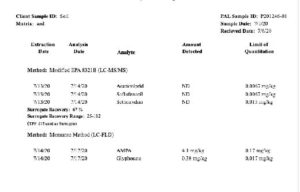
The section of field dedicated to the study was separated into 6 different 10’ X 25’ plots. Each plot was sampled in three separate locations at the depth of 5”, the sample sites were flagged for resampling at a later date, and the samples from each respective plot were homogenized and submitted to the lab for glyphosate and AMPA analysis.
For the purpose of this study 3 of the plots received a fungal inoculation, and seeded with cover crop, and 3 plots served as controls. Each 10’ X 25’ plot was assigned a number 1-6, and treatments were assigned at random.
For each Fungal Treatment Plot received 0.5 cubic yard (14 cubic feet) of rice straw/rice hull oyster mushroom spawn (mushroom impregnated substrate). This mushroom spawn was rototilled into the top several inches of soil, and seeded with cover crop
(vetch, clover, faba, wheat).
The Control Plots received one of the three following treatments respectively: application of 0.5 cu.ft. of uninnoculated rice straw/hulls and seeded with cover crop (termed “mulched” for the purposes of this study), cover crop only, and no treatment/no irrigation/no mulch. Overhead irrigation was applied to all of the plots over the duration of the study sufficient to sustain cover crop, with the exception of the “no treatment” plot which was not rototilled, left as bare soil, and no irrigation was applied.
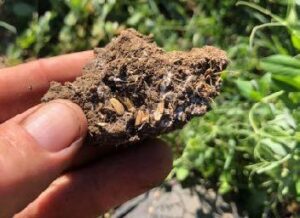
After the period of 60 days, the cover crop began to flower; the point in time at which cover crops are typically mowed/tilled-in. At this time the soil was resampled. The original 3 sample sites per plot were identified, sampled to the depth of 5” and homogenized prior to be submitted to the lab for analysis.
Part 2: Reduction of Fire Borne Toxin on Fire-affected Ranch
The second project is emerges from the “Camp Fire” which ravaged Northern California in November of 2018, totally leveling the town of Paradise. As we continue to see fire-storm’s impact on the urban-agrairian gradient of California, it is important to understand the impact of these fires on soils.
The Camp Fire Resource Monitoring and Research Symposium on June 4th at Chico State University Chico, brought together researchers and extension agents who have been examining impacts and contamination in the wake of the Camp Fire and lessons learned from the Santa Rosa and Carr fire. Jackson Webster and Sandrine Matiasek of CSU Chico have been sampling creeks throughout Butte County. Their preliminary research indicates that fire baked soils are hydrophobic and surface flow is precipitating persistent organic toxins and heavy metals into the waterways. The resounding narrative from the symposium is that very little is known about rates of contamination in soils (and virtually no testing for dioxins is being done).
TurkeyTail Farm was one of the farms destroyed during the 2018 Camp Fire. The charred remains of the barns and water system were removed by debris removal contractors, but several areas went unaddressed by this service. Areas that had vehicles and sheds have not been tested for heavy metals and there was no testing for persistent organic pollutants like dioxin, benzene and polycyclic aromatic hydrocarbons. One of the purposes of this study is to get baseline information on the toxins present after forest and structural fires and to build on research already being performed.
The damage to the property was extensive. The property was seated on a steep hill with dense vegetation that had burned at very high temperatures. The RV itself was completely incinerated, leaving just the scorched frame. In addition, the frame was stuck behind two burnt shipping containers with no other access points for debris removal. Over a year after the fire event all the ashen debris remained in place.
A composite sampling of 5 different sites in the ash footprint of the RV were collected and tested for heavy metals, benzenes, dioxins, and PAHs. Heavy metals and dioxins were detected.
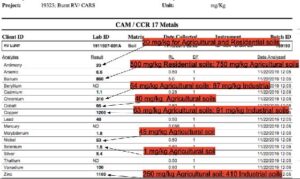
For the purpose of this project Oyster Mushroom (Pleurotus ostreatus) mushroom “spawn bags” were used. “Spawn bag” is the mushroom farming industry term for straw/woodchip filled bags with the fungus growing in it. This mushroom spawn was incorporated in to the debris by hand and top dressed with a layer of Jute Landscape Fabric and straw that had been sterilized in calcium hydroxide. These layers served for moisture protection, but also as an indicator of active mycelial growth.
Oyster mushroom (Pleurotus ostreatus) mycelium grown on rice straw served as a source of fungal inoculum (termed spawn). To grow oyster mushroom spawn, rice straw is pasteurized in a 180 degree Fahrenheit water, drained, then allowed to cool. The straw is inoculated at the rate of 1 part myceliated wood chip spawn to 10 parts pasteurized straw, and then placed in clean bags to incubate for two weeks. After a period of two weeks the fungus completely colonizes to straw and is ready to apply to the field.
To approximately 1 cubic yard of mushroom spawn was used to inoculate each 20’ X 20‘ plot. To maximize soil-mushroom contact, the 20’ X 20’ plots were rototilled lightly to loosen the soil surface, the mushroom spawn was shredded across the plot, and tilled again to integrate mushroom matter and maximize mycelial contact. The plot was then covered with oyster mushroom impregnated jute landscape fabric for moisture retention and additional mycelial mass. Finally the plot was mulched with additional rices straw to protect mushroom spawn and retain moisture. Overhead irrigation was applied as needed to sustain the fungus
Fungus was permitted to grow for a duration of ~6 months, during which it was monitored for active mycelial growth and mushroom emergence. After this period the soil was resampled for contaminates for comparison to baseline levels.

Part 1: Reduction of Herbicides and Pesticides by Fungi on Organic-Transitional Vegetable Farm
Initial, pre-treatment, glyphosate rates ranged from 0.38 mg/kg to 0.089 mg/kg. Initial AMPA rates were significantly higher, ranging from 4.1 mg/kg to 1.4 mg/kg. Over the duration of the study there was a reduction of glyphosate and AMPA in all plots, in some circumstances values being reduced by over half. In the instance of glyphosate, final rates varied from 0.11 mg/kg to 0.036 mg/kg. Values for AMPA ranged from 2.0 mg/kg to 0.92 mg/kg. The greatest overall reduction of glyphosate occurred in Control Plot 6 where no treatment was applied (0.216 mg/kg reduction). In AMPA greatest observed reduction was in Fungal Treatment Plot 1 (2.1 mg/kg).
With variable pesticide rate across all 6 plots in initial samples, the total rate of reduction does not provide clear indication of effectiveness for the treatments. Evaluation on the basis of percentage reduction from initial to final sample, provides a more proportionate perspective on the rate of reduction over time.
When evaluated on the basis percentage reduction over time, the greatest reduction of glyphosate occurred in Control Plot 6 (no treatment) with an 80% reduction. The lowest rate of reduction was in Control Plot 2 (cover crop and rice straw/hulls mulch) with a 33% reduction. The average rate of reduction across all fungal treatments for glyphosate (plot 1,4, and 5) was 62% (standard deviation of 9%), whereas the average for controls (plot 2, 3, and 6) was 60% (standard deviation of 24%).
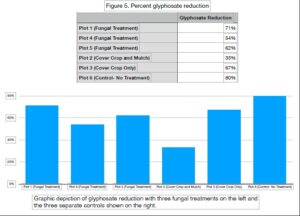
Part 2: Reduction of Fire Borne Toxin on Fire-affected Ranch
In 2005 the World Health organization set the safe and allowable threshold for TEFs/TEQs at 1.0. As seen here the initial toxic ash had a value 8 times that. Over the duration of the treatment there was a nearly 8 fold reduction in TEQ value. While it is possible that the dioxins could have precipitated further into the soil over the duration of the treatment, this RV was placed in a site with particularly poor drainage, and the natural half-life of dioxin is considered to be 8 years. This circumstance offers an encouraging example of the potential for fungi to reduce the toxicity of ashen debris prior to removal and disposal.
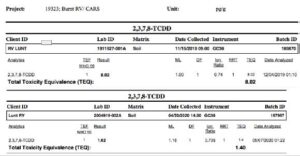
Over the span of the treatment heavy metal values were reduced for most ions. Most noteworthy are barium (near 3X reduction), chromium (over 3X reduction), copper (5X reduction), and zinc (5X reduction). It is worth pointing out the doubling of antimony values from 23 mg/kg to 50 mg/kg between samples. There are several possible explanations for this including sampling error (one particular samples site had a granule of antimony heavy soil), or possible mineralization of toxic metal due to the continued breakdown of toxic materials.
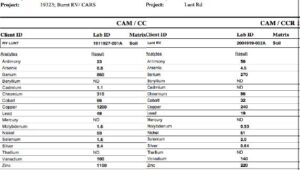
Second Site Similar to the methods described in the circumstance of the RV, mushroom spawn was incorporated into the ash footprint of the vehicles and top dressed with jute. Wattles (straw tubes used for erosion control) were placed on the downhill from the vehicles to try to minimize surface flow of contamination
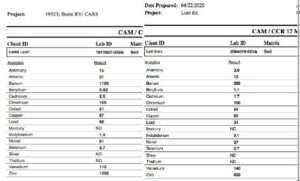
Third Site: Ash footprint was sampled in several locations and soil tests revealed the presence of heavy metals and polycyclic aromatic hydrocarbons. Again, Oyster mushroom spawn was sheet mulched across the area and covered with jute landscape fabric and straw sterilized with calcium hydroxide.
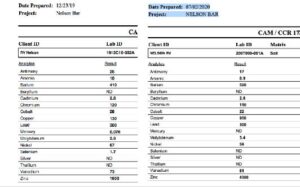
Fungus was permitted to grow for a duration of ~6 months, during which it was monitored for active mycelial growth and mushroom emergence. After this period the soil was resampled for contaminates for comparison to baseline levels.
After a treatment period of 6 months soils were resampled. Results showed the polycyclic aromatic hydrocarbons had been completely ameliorated. It should be noted that initial samples were take over a year after the fire event (speaking to the persistence of PAHs), and with a 6 month fungal treatment the persistent pollutants had been eliminated.
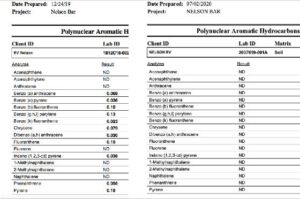
(PAHs) reported in mg/kg on a dry weight basis. Over the duration of the treatment there was a 100% reduction of PAHs for all types. While reduction of heavy metals, for this site treatment was unsuccessful, the total degradation of PAHs marks a successful reduction of toxicity in the ash footprint.
Conversely, some heavy metals levels were actually increased over the duration of the of the treatment. This is possible due to either further degradation of ashen debris or hot spots in sample sites.
Research Outcomes
Education and Outreach
Participation Summary:
Results of these two studies will have far reaching implications for farmers, ranchers and fire affected communities. The results from the pesticide reduction experiment will provide baseline information about the persistence of pesticide residues in soils (based on comparison of the level of organophosphates in the “control”). This in itself may provide valuable information to growers who are transitioning farmland to organic production and want to ensure soil health. Fungal treatments will demonstrate the practicality and feasibility of using fungal enzymes to degrade pesticide residues.
Sampling from fire affected soils will generated base-line information about the types of contaminants generated in fire events that can be communicated to other communities in need. Best Management Practices in the wake of the fire events typically entail deploying erosion control materials like straw wattles and Jute fabric. By augmenting theses materials with fungi, it is possible to not only slow the movement of contaminants across the land, but biologically to immobilize and biodegrade them.
Several forms of media will be employed for Educational Outreach. Dissemination of results and techniques will be carried out through field days, online media, press releases, presentations/slideshows, and radio/podcasts.
Two separate field days will be held on the two respective farms. These workshops will review the science of mycoremediation, the aim and applications of the two separate studies, and results from the experiments. Workshops will present an overview of mushroom cultivation techniques, low tech methods of making large volumes of mushroom mycelium, and methods of making maximum soil to fungus contact. These workshops will be open to the public and advertised to the fire effected community, local growers and through outlets like the Natural Resource Conservation Service and the Resource Conservation District.
Results of this study will be published on the Butte Remediation 501(c)3 website along with results from other similar work. Butte Remediation, a side project of Turkeytail Farm, was established in response to the Camp Fire to provide information and no-cost bioremediation services to underserved fire survivor communities. Much of the background research and techniques employed in this study are innovated by Butte Remediation. Augmented by Butte Remediation, this WSARE research project will reach a larger audience and have far reaching implications.
Fungal bioremediation continues to gain attention in the press, and has been previously used in response to forest fires. The aim of this project is to provide data for the purpose of employing large scale mycoremediation practices for a diversity of environmental pollutants. Upon completions of these projects, a press release will be sent out to local press, to other recently fire affected communities, and agricultural publications like Mod Farmer, Mother Earth News, and Acres USA. This press release will also be sent to radio media and podcast producers.
Results of the study will be offered at the 2020 Ecofarm Conference. Fires were very much a large part of the discussion during the 2018 Ecofarm, occurring just after the Camp Fire. With the continuation of year-round fire season in California, coupled with the lack of understanding about fire-borne toxins and the implications for farmland, this will undoubtedly be of interest to fellow farmers. In addition, University of California Cooperative Extension is planning on having additional fire-research symposiums. The research generated by this study coupled with additional data from Butte Remediation work would be a valuable contribution to the symposium.
Education and Outreach Outcomes
Additional work needs to be done in scalable fungal compost applications for larger organic systems. Fungal based composts and compost teas are currently in-vogue within the organic farming community (i.e. Johnson-Sou/B.E.A.M compost). Low tech mushroom cultivation techniques offer a much more rapid and scalable option to generating fungi on a much shorter time frame. Development of a standard operating procedure for fungal culture that is simple and requires little infrastructure would help fungal-based compost enthusiasts improve their programs.
Information Products
- Butte Remediation (Website)